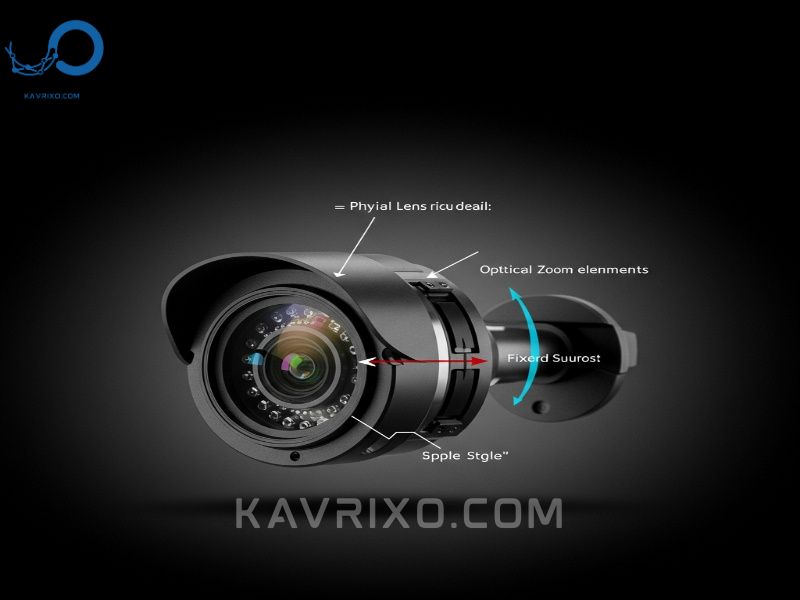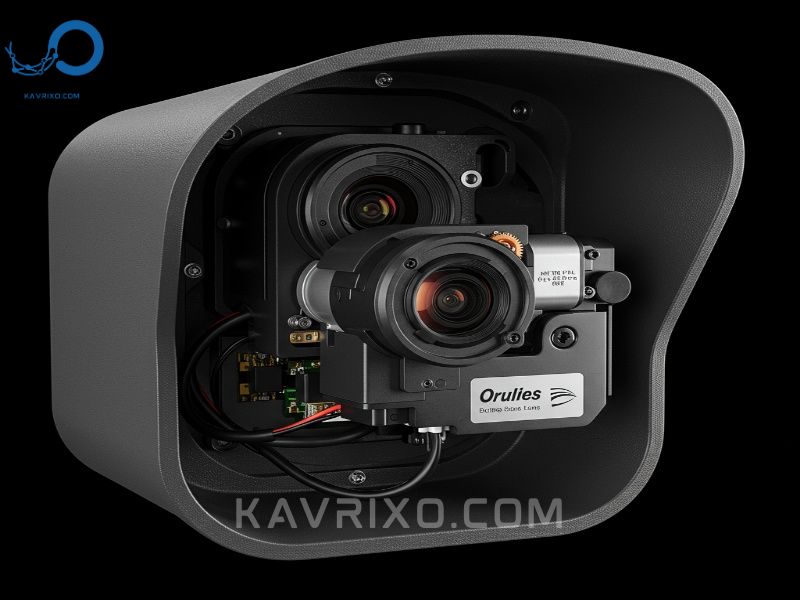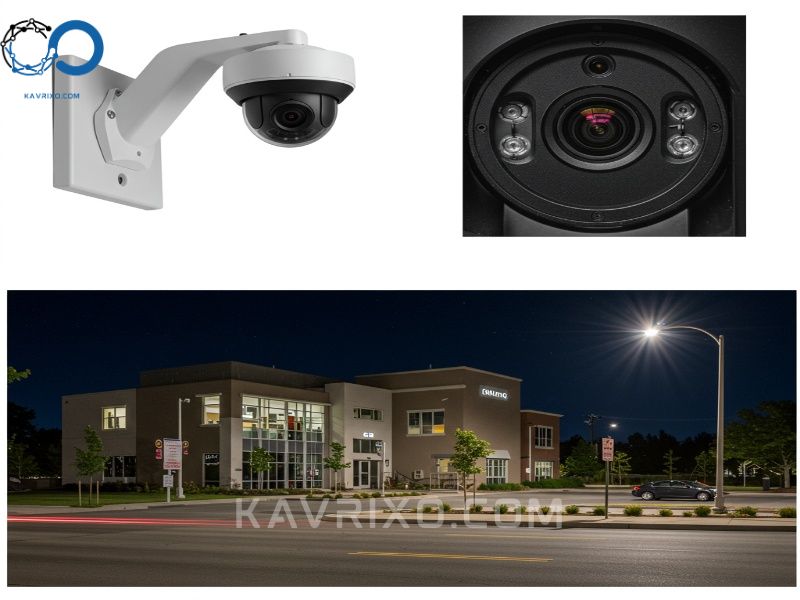In the complex landscape of modern security, clarity is paramount. When monitoring vast properties, expansive parking lots, or long driveways, a standard fixed-lens camera often falls short. You might capture motion, but when it comes time to identify a face, read a license plate, or verify an incident from a distance, the image often degrades into an unrecognizable blur. This is precisely where the specialized technology of a zoom security camera becomes indispensable.
A high-quality zoom security camera is not merely a surveillance tool; it is an investigative asset. It bridges the gap between simply recording an event and capturing the crucial, granular detail needed for identification and prosecution. This comprehensive guide will walk you through the essential components of zoom technology, explaining the critical differences that separate effective long-range monitoring from useless pixelation, helping you identify the best zoom security camera solution for your specific needs.
Contents
- 1 Understanding the Necessity of Zoom in Modern Surveillance
- 2 The Critical Difference: Optical Zoom vs. Digital Zoom
- 3 Types of Zoom Security Cameras
- 4 Key Technical Specifications to Evaluate
- 5 Why Invest in a High-Quality Zoom Security Camera?
- 6 Selecting the Best Zoom Security Camera for Specific Environments
- 7 Installation and Optimization Tips for Your Zoom Security Camera
- 8 Beyond the Basics: Advanced Features of the Best Zoom Security Camera
- 9 The Future of Zoom Technology in Surveillance
Understanding the Necessity of Zoom in Modern Surveillance
The fundamental purpose of surveillance shifts significantly when the area under watch exceeds the capabilities of a typical wide-angle lens. Standard cameras provide a broad overview (the “big picture”), but they lack depth and flexibility. For effective security planning, especially in commercial or large residential settings, the ability to dynamically adjust the view is crucial.
A zoom security camera allows operators to change the focal length of the lens, effectively magnifying distant objects without compromising image quality. This capability transforms passive monitoring into active, responsive surveillance, ensuring that actionable intelligence—like the precise color of a suspicious vehicle or the specific details of an attempted entry—is always within reach, regardless of the distance.
The Critical Difference: Optical Zoom vs. Digital Zoom
The single most important distinction when shopping for any zoom security camera is understanding the difference between optical zoom and digital zoom. Misunderstanding this point is the most common pitfall for new buyers, often resulting in cameras that fail to deliver the promised magnification capabilities.
Understanding Optical Zoom: The Superior Choice
Optical zoom is achieved by physically adjusting the lens elements (the glass components) inside the camera body, much like a traditional photography camera. When you use optical zoom, the camera physically changes its focal length, bringing the light rays from a distant object closer to the image sensor.
The key benefit here is that the image quality remains pristine, even at maximum magnification. If a camera offers 10x optical zoom, it means that the image is magnified ten times using the physical glass lens before the light hits the sensor, ensuring that you maintain the full resolution (e.g., 4 megapixels or 4K) throughout the entire zoom range. For critical long-distance surveillance, optical zoom is the only viable option.

The Limitations of Digital Zoom
Digital zoom, conversely, is not a function of the lens; it is a software manipulation technique. When a camera uses digital zoom, it simply crops the image captured by the sensor and then magnifies that cropped section.
Imagine taking a high-resolution photo and then using your computer’s editing software to zoom in on a small corner of that picture. The closer you zoom, the more pixelated and blurry the image becomes because the software is merely enlarging existing pixels—it is not capturing new detail.
While digital zoom can be useful for minor adjustments on a recorded clip, relying on it for primary surveillance identification is a mistake. If a camera boasts a 30x zoom capability but only 4x optical, the remaining 26x is digital, meaning that beyond 4x, the image detail will rapidly degrade. When seeking the best zoom security camera, always prioritize the optical zoom ratio.
Types of Zoom Security Cameras
While the principle of optical magnification remains constant, zoom security cameras come in several distinct formats, each serving different operational needs and budgets.
Varifocal Cameras (Manual Adjustment)
A varifocal lens is the simplest form of optical zoom. These cameras offer a range of focal lengths (e.g., 2.8mm to 12mm). In older or budget models, the focal length is set manually during installation. The installer physically opens the camera housing and adjusts the lens length to achieve the desired field of view and zoom level for a fixed perspective. Once set, the focal length typically remains locked.
- Pros: Cost-effective, excellent image quality at the set focal length.
- Cons: No remote adjustment; lack of flexibility after installation.
Motorized Varifocal Cameras (Remote Adjustment)
Motorized varifocal (or simply motorized zoom) cameras are a significant step up. While they still function as fixed-position cameras (they don’t pan or tilt), their lens adjustments can be controlled remotely via the camera software or NVR/DVR interface. This allows operators to fine-tune the field of view or zoom in on a specific distant object without physically climbing a ladder.
This type of zoom security camera is ideal for perimeter surveillance where the camera needs to remain pointed in one direction but the operator occasionally needs to zoom in for detailed inspection (e.g., monitoring a specific gate 100 yards away).
Pan-Tilt-Zoom (PTZ) Cameras: The Ultimate Flexibility
PTZ cameras are the pinnacle of dynamic surveillance. These cameras combine powerful optical zoom capabilities (often 20x, 30x, or even 40x) with the ability to remotely pan (move horizontally) and tilt (move vertically).
PTZ units are designed for active monitoring. A single PTZ camera can potentially replace multiple fixed cameras by covering a massive area through pre-set patrol routes or manual operator control. Advanced PTZ models often feature:
- Auto-Tracking: The ability to automatically follow a moving person or vehicle within the frame.
- Guard Tours: Pre-programmed sequences of pan/tilt movements and zoom presets, ensuring continuous coverage of designated checkpoints.
- Speed Domes: High-speed PTZ cameras capable of rapidly repositioning to capture fast-moving targets.
If your requirement is not just long-range viewing but also the flexibility to change the viewing area dynamically, a PTZ camera is the best zoom security camera choice, despite the higher investment.

Key Technical Specifications to Evaluate
When evaluating different models, buyers must look beyond simple marketing claims and focus on specific technical metrics that determine real-world performance.
Magnification Power: The Optical Zoom Ratio
As emphasized, the primary specification is the optical zoom ratio (e.g., 4x, 12x, 30x).
- 4x Zoom: Suitable for small to medium properties, covering detailed views up to 50-75 feet. Common in motorized varifocal turret or dome cameras.
- 10x to 20x Zoom: Excellent for medium-to-large parking lots, industrial yards, or long driveways, providing clear detail up to 150-300 feet.
- 30x+ Zoom: Reserved for professional and commercial applications like city surveillance, port monitoring, or large campus security, capable of identifying targets up to 500-1000 feet away under ideal conditions.
A crucial consideration is the minimum focal length (the widest angle). Some high-zoom cameras (30x) start at a narrow field of view (e.g., 6mm), which means they don’t capture a wide area up close. The ideal zoom security camera balances a wide starting view (e.g., 4.5mm) with a powerful maximum zoom.
Resolution and Field of View (FOV)
Zoom capability is useless without sufficient resolution. When you zoom in on a distant object, you are concentrating the available pixels onto that smaller target.
- 4MP (2K) or 5MP: These resolutions are often the sweet spot for many residential and small commercial zoom applications, offering a balance between detail and storage/bandwidth requirements.
- 4K (8MP): While 4K provides phenomenal detail, be mindful that 4K video streams consume massive amounts of bandwidth, especially when actively zooming. Ensure your network infrastructure can handle the load.
Furthermore, consider the Field of View (FOV). The FOV decreases dramatically as you zoom in. A camera with 10x zoom might have a 90-degree FOV at its widest setting and shrink to a narrow 3-degree view when fully zoomed in. This narrow view is necessary for detail capture but requires precise aiming.

Auto-Focus Speed and Accuracy
One of the most common complaints about poorly designed zoom security camera systems is slow or inaccurate auto-focus. When a camera zooms from wide angle (e.g., monitoring a parking lot) to full magnification (e.g., reading a distant sign), the lens must rapidly refocus.
If the auto-focus system is slow, the operator might miss the critical moment of identification. High-quality cameras use sophisticated algorithms and fast motors to achieve sharp focus in less than a second, even across large focal length changes. When testing or reviewing models, prioritize those known for rapid and reliable focusing capabilities.
Low-Light Performance and IR Range
Long-range surveillance often takes place at night. The effectiveness of a zoom security camera in darkness depends on two factors:
- Low-Light Sensor Performance (Starlight/DarkFighter): Cameras equipped with large, sensitive sensors can capture color images in very dim conditions, often long after standard cameras switch to black and white.
- Infrared (IR) Illumination Range: Since the camera is viewing objects far away, its integrated IR LEDs must be powerful enough to illuminate that distance. A camera with 30x zoom needs IR illumination that reaches at least 300-500 feet. Always check the specified IR distance and ensure it aligns with the camera’s maximum effective optical zoom range.
Why Invest in a High-Quality Zoom Security Camera?
The investment in a premium zoom unit pays dividends primarily through enhanced identification capabilities and operational flexibility.
Surveillance of Large Properties
For properties like warehouses, farms, sports fields, or expansive industrial parks, covering the area with fixed cameras can be prohibitively expensive and complex. A few strategically placed PTZ or motorized zoom cameras can offer superior coverage and detail capture. They allow security personnel to patrol virtual boundaries quickly and confirm potential threats across miles of perimeter.
Identification and Evidentiary Detail
The difference between a useful surveillance clip and a useless one often comes down to detail. Standard cameras might show a person breaking a window, but a high-powered zoom security camera can confirm the color of their jacket, the logo on their bag, or the specific tool they used—details crucial for law enforcement. For applications requiring facial recognition or license plate capture (LPR) at a distance, optical zoom is mandatory.

Selecting the Best Zoom Security Camera for Specific Environments
The ideal camera solution depends heavily on the environment it will be deployed in.
Residential vs. Commercial Needs
Residential Use:
For most homes, the primary concern is usually the driveway, backyard fence line, or the approach from the street. A motorized varifocal camera offering 4x to 10x optical zoom is often sufficient. These cameras are typically more discreet and integrate easily with standard home security ecosystems. They provide enough detail to identify trespassers or vehicles at the property line (up to 100 feet).
Commercial/Industrial Use:
These environments demand ruggedness and extreme reach. Industrial applications often require 20x to 40x PTZ cameras, sometimes coupled with thermal imaging capabilities. The environment also dictates durability requirements (e.g., explosion-proof housings, anti-corrosion coatings). The focus shifts from general monitoring to incident verification and perimeter integrity.
Indoor vs. Outdoor Durability (IP Ratings)
Any zoom security camera deployed outdoors must have an appropriate Ingress Protection (IP) rating.
- IP66: Protects against dust and powerful jets of water, suitable for general outdoor use.
- IP67: Offers superior protection, suitable for areas prone to heavy rain or temporary submersion.
- IK Ratings: For areas susceptible to vandalism (like public parking garages), look for a dome camera with an IK rating (IK10 being the highest), indicating resistance to impact.
Since outdoor zoom cameras contain moving parts (the lens motor and, for PTZs, the pan/tilt mechanism), robust weather sealing is critical to prevent moisture from damaging the intricate optical components.

Installation and Optimization Tips for Your Zoom Security Camera
Even the best zoom security camera will perform poorly if installed incorrectly or if the network is inadequate.
Strategic Mounting Locations
The placement of a zoom camera is crucial for maximizing its reach and effectiveness.
- Height: Mount the camera high enough (typically 15-30 feet) to ensure a clear line of sight over potential obstacles (trees, vehicles) and to prevent easy tampering.
- Angle: For perimeter monitoring, mount cameras to view along the boundary line (longitudinally) rather than directly facing away from the wall (transversely). This maximizes the focal distance covered by the optical zoom.
- Stability: PTZ cameras, in particular, must be mounted on extremely stable, non-vibrating surfaces (e.g., concrete poles, reinforced walls). Any slight shake is magnified significantly at high zoom levels, making the image unusable.
Bandwidth Considerations for High-Resolution Zoom Feeds
High-resolution video streams (4K) from a zoom security camera, especially when actively panning and zooming, generate enormous amounts of data. This traffic can easily saturate standard residential or outdated commercial networks.
To mitigate this:
- Use H.265+ Compression: Ensure your cameras use advanced compression codecs (like H.265 or proprietary variations like H.265+) to reduce file size without losing critical detail.
- Prioritize Quality of Service (QoS): Configure your network router to prioritize the surveillance video streams to minimize latency and dropped frames.
- Dedicated NVR/DVR Network: Ideally, surveillance traffic should run on a separate, dedicated PoE (Power over Ethernet) network switch, isolated from general office or residential Wi-Fi traffic.
Beyond the Basics: Advanced Features of the Best Zoom Security Camera
To identify the absolute best zoom security camera for professional environments, consider advanced features that enhance usability and intelligence.
Smart Detection and Analytics
Modern zoom cameras are not just recording devices; they are intelligent sensors. Look for integrated analytics that leverage the clarity provided by the optical zoom:
- Line Crossing Detection: Alerts you when an object crosses a defined virtual line.
- Intrusion Detection: Alerts you when an object lingers too long in a predefined zone.
- Target Classification: Sophisticated PTZ cameras can distinguish between vehicles, people, and animals, reducing false alarms and ensuring that the auto-tracking feature only engages on relevant targets.
WDR (Wide Dynamic Range) and Backlight Compensation (BLC)
When zooming in on a distant area, the lighting conditions can be challenging. For example, if you are monitoring a gate at dusk, the bright headlights of a vehicle might overexpose the license plate, rendering it unreadable. WDR technology balances the extremely bright and dark areas in the same scene, ensuring that critical details are visible even in high-contrast situations. This is non-negotiable for effective long-range identification.

The Future of Zoom Technology in Surveillance
The trajectory of zoom security camera technology points toward even greater integration of AI and extended optical capabilities. We are seeing faster auto-focus systems, higher zoom ratios (50x and 60x optical zoom are becoming more common), and the proliferation of multi-sensor systems.
Future systems will likely combine a fixed wide-angle lens (to maintain the full overview) with a dedicated PTZ module (for detailed zooming), all housed within a single unit and seamlessly managed by AI that automatically directs the zoom lens toward anomalies detected by the fixed lens.
For anyone serious about protecting large assets or requiring undeniable evidentiary footage, investing in a robust, optically superior zoom security camera system is a necessary step in modern security infrastructure. By understanding the core principles of optical zoom, prioritizing resolution, and selecting the appropriate camera type (varifocal or PTZ), you ensure your surveillance system captures the clarity and detail required to keep your property safe.
